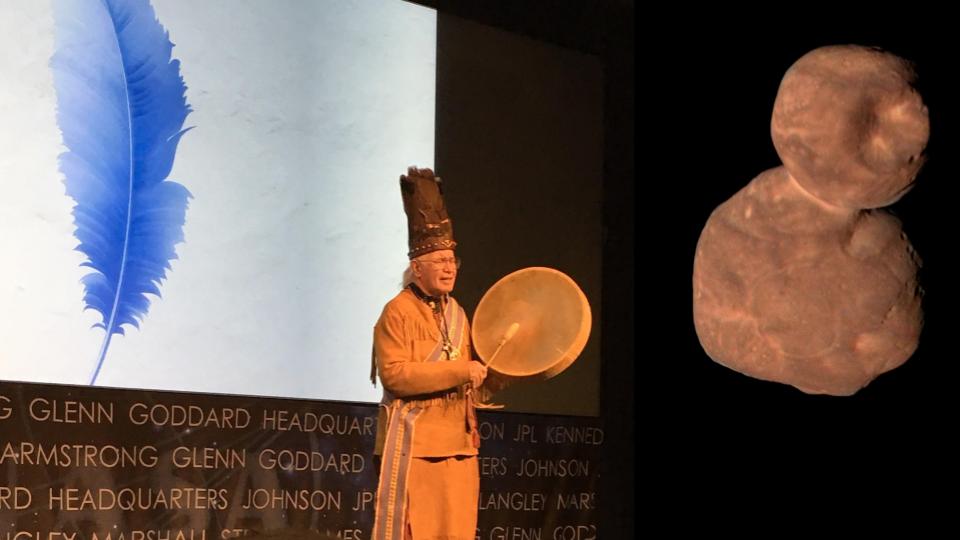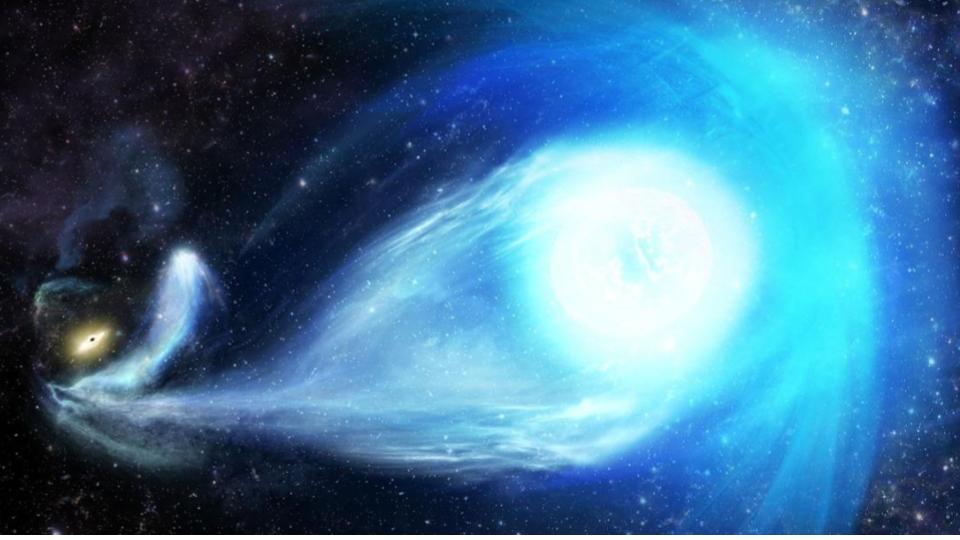Today our science is on the run in various directions. Hyabusa 2 is heading home after exploring Ryugu, the Kuiper Belt Object MU69 gets an official name, and a supermassive black hole kicks a star out of the Milky Way.

- Hayabusa2 departs from Ryugu (JAXA)
- Hayabusa 2 Project (JAXA)
- Hayabusa2 (Wikipedia)
We would like to start today’s episode by congratulating the JAXA space agency and the international team of scientists who are working with the Hayabusa 2 mission for their successful 17 month mission at the asteroid Ryugu.
This little spacecraft departed Earth in December 2014, and arrived at Ryugu in the summer of 2018. Since it’s arrival, it has dropped flitting robot cameras onto this rocky asteroid, bombed Ryugu to create new craters, and collected multiple samples from this rubble pile asteroid.
The journey home won’t be fast. Hyabusa 2 is powered by an ion engine, and had an initial velocity of just 9.2 cm/s. It is accelerating, but this is a remarkable, not dramatic departure.
In December of 2020, roughly 13 months from now, Hayabusa 2 will return it’s sample to Earth, with the collection capsule falling to Australia and then being transported to laboratories in Japan for processing.

- New Horizons Kuiper Belt Flyby Object Officially Named ‘Arrokoth‘ (New Horizons)
- Arrokoth (2014 MU69) (NASA Solar System Exploration)
- MU69 – 486958 Arrokoth (Wikipedia)
In other pleasing news, the Kuiper Belt object that New Horizons visited last New Years, MU69, has finally been given an official name. This name is in Powhatan/Algonquian language. Arrokoth means “sky” in this language of the indigenous peoples of the central Atlantic Coast, in the Chesapeake Bay region where we have modern day Virginia.
At naming ceremony at NASA headquarters on Tuesday, Rev. Nick Miles, of the Pamunkey Tribe, performed a traditional opening and tribe member Dr. Phoebe Farris introduced this name. This is an official International Astronomical Union designation.
MU69, now Arrokoth, was discovered in 2014 using the Hubble Space Telescope by New Horizons scientists led by Marc Buie. According to Buie, “Data from the newly-named Arrokoth, has given us clues about the formation of planets and our cosmic origins. We believe this ancient body, composed of two distinct lobes that merged into one entity, may harbor answers that contribute to our understanding of the origin of life on Earth.”
Today is a day where it feels like our science is on the run. From Hyabusa 2 coming home after exploring Ryugu, and from a tale of the KBO New Horizons visited on its way out of the solar system, we now turn to the story of a star on its way out of our galaxy.

- Hyper-fast star ejected by supermassive black hole (Royal Astronomical Society)
- Runaway Star Was Ejected From The “Heart Of Darkness” (Carnegie Science)
- Milky Way’s big black hole hurls star to infinity and beyond (Australian National University)
While looking for the streams of stars associated with small galaxies disrupted by our Milky Way, scientists using the 3.9 meter Anglo-Australian telescope stumbled upon a star moving more than 6 million km/h on a trajectory that will take it out of this galaxy.
By running it’s motion backwards, they were able to determine that when this star likely started its journey in the core of our galaxy, the Milky Way’s supermassive black hole did something to send it flying. Most likely, a three-body interaction between the black hole, this star, and a former binary companion, led to the companion star getting captured into a small orbit around the black hole while this star was cast out. It is estimated this star will leave the Milky Way in just 100 million years. While this tells a terrible tale of a binary star system torn asunder, this is a case where quite likely all the objects survived, and where a black hole flung an object instead of consuming it.
That rounds out our show for today.
Thank you all for listening. The Daily Space is produced by Susie Murph, and is a product of the Planetary Science Institute, a 501(c)3 non profit dedicated to exploring our Solar System and beyond. We are made possible through the generous contributions of people like you. If you would like to learn more, please check us out on patreon.com/cosmoquestx. During the month of November we are running a special fundraiser to support our server costs for 2020. We project costs of $1450 for all of our websites. If you would like to help us reserve our place on the internet, you can donate at streamlabs.com/cosmoquestx. Your donations are tax deductible where allowable in the world.
Each live episode of the Daily Space is archived on YouTube. If you miss an episode here on Twitch.tv, you can find it later on youtube.com/c/cosmoquest. These episodes are edited and produced by Susie Murph.
We are here thanks to the generous contributions of people like you who allow us to pay our staff a living wage. Every bit, every sub, and every dollar committed on Patreon.com/cosmoquestx really helps. If you can’t give financially, we really do understand, and there are other ways you can help our programs. Right now, the best way you can help is to get the word out. Let you friends know, share our channel to your social media, or leave a recommendation. You never know what doors you are opening.
We really wouldn’t be here without you – thank you for all that you do.


 We record most shows live, on Twitch. Follow us today to get alerts when we go live.
We record most shows live, on Twitch. Follow us today to get alerts when we go live.